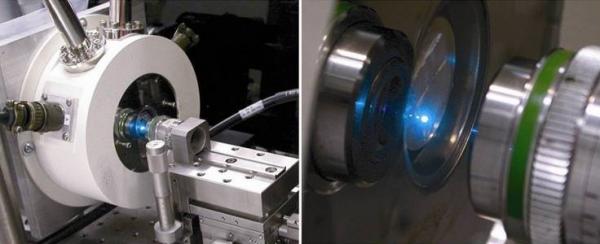Air Force Office of Scientific Research and National Science Foundation-funded professor, Dr. Xiang Zhang has demonstrated at the University of California, Berkeley the world's smallest semiconductor laser, which may have applications to the Air Force in communications, computing and bio-hazard detection.

AFOSR-MURI and National Science Foundation-funded professor, Dr. Xiang Zhang has demonstrated at the University of California, Berkeley the world’s smallest semiconductor laser, which may have applications to the Air Force in communications, computing and bio-hazard detection. (Credit: Image courtesy of Air Force Office of Scientific Research)
The semiconductor, called a plasmon, can focus light the size of a single protein in a space that is smaller than half its wavelength while maintaining laser-like qualities that allow it to not dissipate over time.
"Proposed almost seven years ago, researchers had been unable to demonstrate a working plasmonic laser until our experiment," said Zhang. "It is an important discovery because it has the potential to eliminate optical loss and make plasmonic-based technologies viable for a broad spectrum of applications."
"Perhaps the biggest gap in our knowledge and the reason it took so long to demonstrate this technology was our challenge of devising a realistic plasmonic laser design," he said. "We developed a strategy to get around this problem by combining semi-conductor nanowires one-thousand times thinner than a human hair with a metal surface separated by an insulating gap of only five nanometers, the size of a single protein molecule."
Because of their ultra small size, Zhang admits that an even more challenging aspect of his research has been in demonstrating how the plasmonic lasers bridge electronics, optics and photonics on the nanometer scale.
"We were ultimately able to exhibit these properties successfully by creating a confined space that was able to hold and sustain light while the experiments were conducted," he noted.
The next generation of plasmonic lasers called nanolasers are even expected to be able to probe and manipulate molecules. They will be of interest to the Air Force because they will advance ultra-sensitive bio-detection, nanoscale optics and enhanced communication systems.
They will also benefit healthcare, optics-based telecommunications and optical computing.
Zhang looks forward to the next phase of research when he and his colleagues will create an electrically operated version of the plasmonic laser, which can be fully integrated with semiconductors without design modification.
Story Source:Adapted from materials provided by Air Force Office of Scientific Research.
(责任编辑:董静)